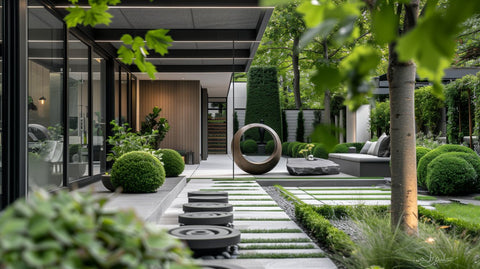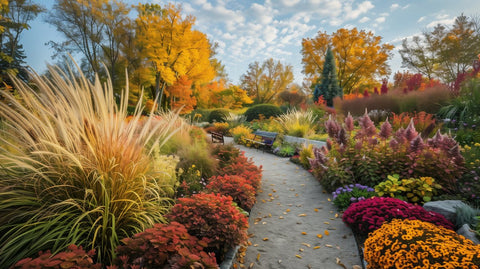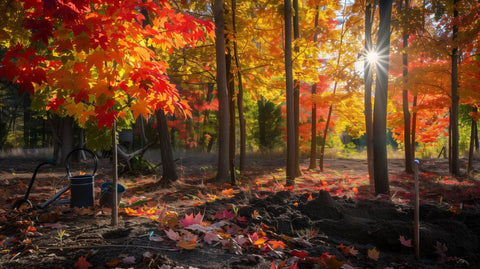This blog post explores the principles and elements of modern garden design, offering tips and inspiration for creating a contemporary outdoor space. From planning the layout to selecting plants and hardscaping elements, you'll learn how to infuse your garden with a modern aesthetic. Whether you're working with a small urban garden or a larger suburban space, this guide will help you create a garden that's both functional and visually stunning. Explore some of the exquisite plant selections available at Plantology USA to bring your modern garden to life.
I. Introduction
When you think about modern garden layouts, what comes to mind? Sleek lines, minimalistic plantings, and a perfect blend of nature with man-made structures. Modern garden design is all about creating a space that feels both contemporary and inviting. Whether you’re working with a sprawling backyard or a compact urban plot, infusing your garden with contemporary flair can transform it into an oasis that reflects the very best of modern design.
In this post, we’re going to explore the principles of modern garden layouts, how to design your own contemporary garden, and ways to add that extra touch of modern sophistication. Let’s dive in and discover how you can turn your outdoor space into a modern masterpiece!

II. Key Principles of Modern Garden Layouts
A. Simplicity and Minimalism
The foundation of modern garden design lies in simplicity and minimalism. This approach strips away unnecessary elements, leaving behind a clean, uncluttered space that allows key features to shine. In a modern garden, every element serves a purpose, contributing to the overall aesthetic while maintaining a sense of order and tranquility.
Minimalism in garden design often involves using a limited palette of materials and plants, focusing on textures and forms rather than an abundance of colors or varieties. This creates a cohesive look that’s easy on the eyes and calming to the mind.

Explore minimalist plant options such as the Agave Blue or the sleek Ficus Burgundy Bush.
B. Use of Geometric Shapes
Geometric shapes are a hallmark of modern garden design. From perfectly straight pathways to circular plant beds, geometric patterns bring structure and rhythm to the space. These shapes can be used in various elements of the garden, including paving, garden beds, and even water features.
Incorporating geometric shapes helps to create a sense of order, making the garden feel more organized and intentional. This is especially effective in smaller spaces where every square foot counts.

Consider adding a geometric touch with the stunning Snake Plant (Sansevieria Zeylanica) or the architectural Yucca Cane.
C. Integration of Natural and Man-Made Materials
One of the most intriguing aspects of modern garden design is the seamless integration of natural and man-made materials. Concrete, metal, and glass are often paired with wood, stone, and greenery to create a dynamic contrast. This blend of materials adds depth and interest to the garden, making it visually engaging from every angle.
For example, a concrete patio might be softened with the addition of wooden furniture and lush potted plants. Similarly, a metal sculpture can stand out against a backdrop of natural stone or greenery, creating a striking visual impact.

Pair natural elements with the striking Monstera Deliciosa or the exotic Alocasia Amazonica Polly to achieve this balance.
D. Focus on Functionality
Modern gardens are not just about aesthetics; they are also designed to be functional. This means creating spaces that serve multiple purposes, whether it’s a quiet retreat, an outdoor dining area, or a space for children to play. Every element in a modern garden should be carefully considered for its practicality as well as its visual appeal.
For instance, raised garden beds can double as seating areas, while a water feature can provide both a soothing soundscape and a focal point. By focusing on functionality, you can create a garden that is not only beautiful but also perfectly suited to your lifestyle.

Enhance functionality with multi-purpose plants like the durable Ficus Green Island or the versatile Aglaonema Silver Bay.
III. Designing a Modern Garden Layout
A. Planning the Space
The first step in designing a modern garden is planning the layout. This involves assessing the available space, understanding the garden’s purpose, and determining how best to use the area. Start by sketching a rough layout, taking into account the sun’s path, existing structures, and any natural features you want to highlight.
When planning your garden, think about how you want to use the space. Do you want a quiet area for reading, a space for entertaining, or a garden that’s focused on sustainability? Your answers will guide the design process and help you create a layout that meets your needs.

Consider incorporating versatile plants like the Areca Palm for shading and privacy, or the striking Agapanthus Lily of the Nile for creating visual interest along pathways.
B. Choosing a Focal Point
A well-designed modern garden often features a focal point that draws the eye and serves as the centerpiece of the space. This could be anything from a striking piece of sculpture to a beautiful tree or a water feature. The key is to choose something that resonates with your personal style and complements the overall design of the garden.
Your focal point should be positioned in a way that it can be appreciated from various angles. This might mean placing it at the end of a pathway, in the center of the garden, or against a neutral backdrop that allows it to stand out.

Enhance your garden’s focal point with complementary plants like the architectural Alocasia Calidora or the bold Super Dwarf Cavendish Banana.
C. Selection of Plants
1. Modern Plant Choices
In a modern garden, plant selection is crucial. Opt for plants that have a strong architectural form and can serve as statement pieces in the garden. Succulents, ornamental grasses, and plants with bold foliage are all excellent choices. Consider the color, texture, and form of each plant, and how they will contribute to the overall aesthetic.
When choosing plants, think about how they will look throughout the year. Evergreen plants are particularly useful in modern gardens, as they provide structure and color even in the colder months.

Popular choices include the stunning Aloe and the elegant Anthurium Jungle, both of which bring a modern edge to any garden.
2. Low-Maintenance Plants
Low-maintenance plants are ideal for modern gardens, especially if you want to maintain a clean, uncluttered look with minimal effort. Drought-resistant plants, such as lavender, yucca, and agave, are perfect for modern gardens, as they require little water and upkeep. These plants also tend to have striking forms that add visual interest.
By choosing low-maintenance plants, you can ensure your garden remains attractive throughout the year without demanding constant attention. This allows you to enjoy your garden as a relaxing space rather than a chore.

For a low-maintenance garden, consider the hardy Caribbean Agave or the versatile Boston Fern.
D. Incorporating Hardscaping Elements
1. Pathways and Walkways
Pathways are a key element in modern garden design, guiding visitors through the space and connecting different areas of the garden. In a modern garden, pathways are often made from materials like concrete, gravel, or large pavers, arranged in clean, straight lines or geometric patterns. The materials should complement the overall design and create a cohesive look.
Consider the practical aspects as well, such as ensuring the pathways are wide enough for comfortable walking and using materials that are durable and weather-resistant.

Add a touch of modern elegance with the sleek Juniper Parsonii or the lush Areca Palm lining your pathways.
2. Outdoor Structures
Outdoor structures, such as pergolas, seating areas, and garden walls, play a significant role in modern garden design. These structures not only provide functionality but also contribute to the aesthetic appeal of the garden. In a modern garden, structures are typically made from materials like wood, metal, or glass, and feature clean lines and simple forms.
A pergola, for example, can create a shaded seating area, while a garden wall can serve as a backdrop for plants or art. The key is to choose materials and designs that complement the rest of the garden and enhance its modern look.

Frame your structures with the lush Ficus Green Island or the vibrant Bougainvillea Trellis Miami Pink for a perfect modern touch.
3. Water Features
Water features are a popular element in modern gardens, adding a sense of tranquility and movement to the space. Whether it’s a simple reflecting pool, a modern fountain, or a sleek water wall, these features can serve as a focal point and enhance the garden’s ambiance. In modern designs, water features are often minimalist in style, with clean lines and smooth surfaces.
When incorporating a water feature, consider its placement and how it will interact with other elements in the garden. Ensure it is visible from key areas and that it complements the overall design.

Pair your water feature with lush greenery like the tropical Alocasia Portora or the vibrant Alocasia Lutea.
IV. Enhancing the Modern Garden with Contemporary Flair
A. Lighting Design
Lighting is a crucial element in modern garden design, as it highlights key features and creates ambiance after dark. In a modern garden, lighting is often subtle and strategic, using LED strip lights, solar-powered lights, or spotlights to illuminate pathways, plants, and architectural elements. The goal is to create a warm, inviting atmosphere that extends the usability of the garden into the evening.
Consider using uplights to highlight trees or sculptures, and pathway lights to guide visitors through the space. Modern garden lighting should be both functional and aesthetically pleasing, enhancing the garden’s design without overwhelming it.

Enhance your garden’s ambiance with the subtle glow of well-placed lighting around the majestic Foxtail Palm or the serene White Bird of Paradise.
B. Art and Sculptures
Art and sculptures can add a unique, personal touch to your modern garden, serving as focal points or subtle accents. In a modern garden, sculptures are often abstract or minimalist in design, made from materials like metal, stone, or glass. These pieces can be positioned in strategic locations to draw the eye and enhance the garden’s overall aesthetic.
When selecting art for your garden, consider the scale, material, and placement. The artwork should complement the garden’s design and feel like an integral part of the space.

Complement your art with the striking Desert Rose or the elegant Bottle Palm for added sophistication.
C. Furniture and Decor
Furniture and decor play a vital role in creating a modern garden with contemporary flair. Choose sleek, minimalist furniture that complements the garden’s design and offers comfort and style. Materials like teak, aluminum, and weather-resistant fabric are popular choices for modern outdoor furniture.
Decor elements, such as planters, fire pits, and outdoor rugs, can add personality and warmth to the space. The key is to choose items that enhance the garden’s modern aesthetic while providing functionality and comfort.

Pair your furniture with versatile plants like the lush Dracaena Marginata or the stylish Alocasia Dark Star.
D. Technology Integration
Incorporating smart technology into your garden can enhance its functionality and sustainability. Automated irrigation systems, smart lighting, and app-controlled water features are just a few examples of how technology can be integrated into a modern garden. These systems not only make garden maintenance easier but also allow you to create a garden that is responsive to your needs and the environment.
Consider using a smart irrigation system that adjusts watering schedules based on weather conditions, or installing smart lights that can be controlled remotely. These technologies add a layer of convenience and modernity to your garden.

Complement your technology-enhanced garden with resilient plants like the Ficus Burgundy Bush or the adaptable Foxtail Fern.
V. Examples of Modern Garden Layouts
A. Small Urban Gardens
Urban gardens, often limited in space, are perfect candidates for modern design. With a focus on maximizing every square foot, these gardens often utilize vertical space, container gardening, and multi-functional elements. Modern urban gardens may feature clean lines, minimalist plantings, and smart technology to create a green oasis amidst the cityscape.
For example, a small balcony might be transformed into a lush retreat with vertical planters, sleek outdoor furniture, and a simple water feature. The key is to keep the design minimal yet impactful, ensuring that the space feels both functional and inviting.

Maximize your urban garden with space-efficient plants like the versatile Calathea Exotica or the stylish Aloe.
B. Suburban Gardens with Contemporary Flair
Suburban gardens offer more space, allowing for a greater variety of features and plantings. A modern suburban garden might include a mix of hardscaping elements like concrete patios, raised garden beds, and outdoor dining areas. The design often incorporates clean lines and a cohesive color palette, creating a seamless flow between different zones of the garden.
In a larger space, consider dividing the garden into different functional areas, such as a relaxation zone, a dining area, and a play area for children. The use of modern materials and plants ensures that the garden remains stylish and easy to maintain.

Create distinct zones in your garden with plants like the versatile Ficus Triangularis or the elegant Bougainvillea Bush Barbara Karst.
C. Sustainable Modern Gardens
Sustainability is a growing trend in modern garden design, with many homeowners seeking to create gardens that are environmentally friendly and resource-efficient. A sustainable modern garden might feature native plants, rainwater harvesting systems, and materials made from recycled or sustainable sources.
The goal is to create a garden that not only looks good but also supports local ecosystems and reduces environmental impact. By choosing sustainable practices and materials, you can create a garden that is both beautiful and responsible.

Incorporate sustainability with the low-water Sansevieria Sayuri or the hardy Tasmanian Flax Lily.
VI. Tips for Maintaining a Modern Garden
A. Regular Pruning and Maintenance
Maintaining a modern garden requires regular care to keep it looking its best. Pruning is essential to maintaining the clean lines and minimalist aesthetic that modern gardens are known for. Regularly trim hedges, shape plants, and remove any dead or overgrown foliage to keep the garden looking neat and tidy.
In addition to pruning, consider scheduling regular maintenance tasks such as weeding, mulching, and checking irrigation systems. This will help ensure that your garden remains healthy and attractive throughout the year.

Make maintenance easier with low-maintenance plants like the Blue My Mind Glory or the durable Philodendron Summer Glory.
B. Seasonal Updates
One of the joys of gardening is watching your space evolve with the seasons. In a modern garden, seasonal updates can keep the design fresh and dynamic. Consider planting seasonal flowers or adding new decor elements that reflect the changing seasons. For example, you might introduce warm-toned plants and cozy textiles in the fall, or bright, cheerful flowers in the spring.
Updating your garden with the seasons not only enhances its visual appeal but also keeps it interesting and inviting throughout the year.

Update your garden with seasonal favorites like the vibrant Poinsettia for winter or the cheerful Lantana Lemon Drop for spring.
VII. Conclusion
Creating a modern garden layout with contemporary flair is an exciting endeavor that allows you to blend aesthetics with functionality. By following the principles of modern design, choosing the right plants and materials, and incorporating unique elements like art and technology, you can transform your outdoor space into a modern masterpiece.
Whether you’re working with a small urban plot or a larger suburban garden, the key is to create a space that reflects your personal style and enhances your lifestyle. Experiment with different ideas, and don’t be afraid to make the garden your own. After all, your garden is an extension of your home—a place to relax, entertain, and connect with nature.
VIII. Additional Resources
A. Recommended Books and Blogs
- The Modern Garden: Ideas and Inspirations for Contemporary Outdoor Spaces
- Minimalist Gardens: Creating Simple and Beautiful Outdoor Spaces
- The Urban Garden: Designing Compact Spaces with Style
B. Product Recommendations
- Stainless Steel Garden Hose - Durable and sleek, perfect for a modern garden.
- Plantology E-Gift Card - The perfect gift for any garden enthusiast.
- Galvanized Steel Planter - A stylish addition to any contemporary garden.






























Comments (0)
There are no comments for this article. Be the first one to leave a message!